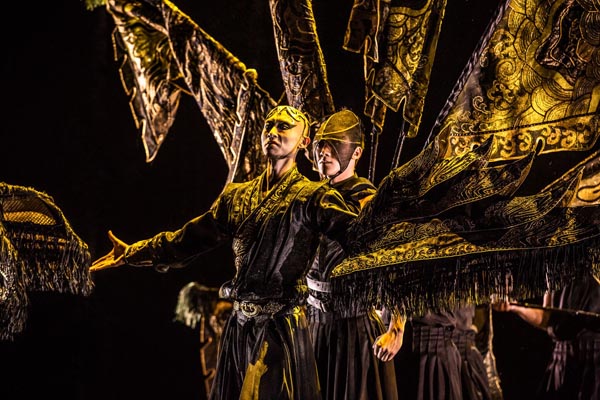
Scenes from the dance-theater production Under Siege, staged in New York on Aug 8. (Photos: China Daily)
A dance-theater piece from renowned Chinese choreographer Yang Liping thrilled the Big Apple.
"It was absolutely fabulous, visually extraordinary, and it's unlike anything I've seen before," Jennifer, editor of a local New York magazine, told China Daily after seeing the debut performance of Under Siege at the David H. Koch Theater at the Lincoln Center in New York on Aug 8.
"The dancers were so athletic, their moves were so beautiful, and the story was so dynamic. I was never bored," she adds.
Under Siege, which explores themes of war, power, betrayal and passion, made its US premiere with performances taking place between Aug 8 to 10 as part of the Mostly Mozart Festival.
Set during the epic battle between the Chu and Han armies in 202 BC, Under Siege blends elements of martial arts, contemporary and Chinese folk dance, gymnastics and more, to interpret an encounter that changed the course of Chinese history.
Yang, chief choreographer and director, said in a previous interview that Under Siege is a conceptual, experimental piece of performance art, which she created with an international perspective.
She attempts to cast a cold vision of the desires and fears that manifest in the depths of the human heart, to hurt and to be hurt, through the story of the Chu-Han Contention more than 2,000 years ago, as a reflection on the present world.
The performance contains many different elements of Chinese art, including those of dance, Peking Opera, music, sculpture and paper-cutting.

Scenes from the dance-theater production Under Siege, staged in New York on Aug 8.
"For me, it's an experiment," Yang says. "Just to show the traditional Chinese elements onstage would be copying what other people have done. So I have melded them with a more contemporary way of passing the message to the audience.
"At the same time, I don't feel that the Chinese audience is ready for only abstract things," she says. "So there needs to be some traditional elements as well. It is a mixture of traditional and abstract. I'm striving for a Chinese way of developing contemporary art and dance onstage."
"The dance of the concubine and Xiang Yu was the most incredible part, with a very high standard. The story was traditional, but the interpretation is very unique," says theatergoer Michale Kuonov after watching the show.
Tim Yip, the Oscar-winning art director of the film Crouching Tiger, Hidden Dragon, supervised costume and set designs for the show.
For Yip, Under Siege is a work that lets him return to tradition. He describes it as an integration of elements of Chinese culture and modern stage art-thousands of scissors hanging on the stage that symbolize a life-threatening crisis, and in the last scene, the stage was covered with red feathers symbolizing the "river of blood" on the ancient battlefield.
While the play debuted in China in 2015, Yip says the US version is slightly different from the Chinese version. "The two cultures are very different from each other; the domestic version is more plump, and this version is more refined and simplified," Yip said in a previous interview with China Daily.
Now in its 53rd season, Lincoln Center's Mostly Mozart Festival is a summertime tradition and a New York institution. Launched in 1966 as America's first indoor summer music festival, with an exclusive focus on its namesake composer, Mostly Mozart has since broadened its focus to include works by Mozart's predecessors, contemporaries and musical successors.


